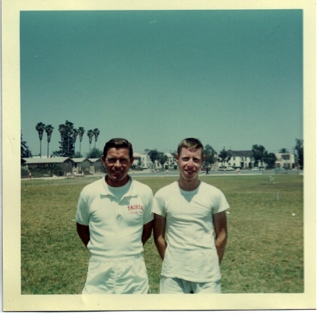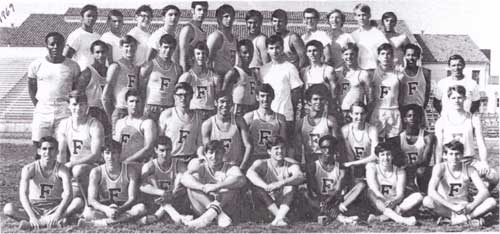(Few readers know that our publisher, Mr. Joel Fox, was a distance runner in the 1960s, and ran
the Boston Marathon in 1969, 1970 and 1971. So I knew he wouldn’t object if I
slipped in as this week’s "California Employment" posting a note on the
distance running subculture of Southern California. A version of this posting
first appeared last week in Zocalo Public
Square.)
Before
distance running entered the mainstream culture in the 1970s, before marathons and
road races attracted thousands of runners, before Nike and Reebok, there was a
distance running subculture in Southern California.
You
wouldn’t have known it existed from the Los
Angeles Times or local television and radio. But a vibrant distance running
community was out there in the 1960s, under the radar. The community was linked
by a network of all-comers races, weekly
road races and the recently-established marathon races. Most consequential,
among this community new ways of thinking were emerging about long distance running as a lifestyle,
as well as about workout regimens, diet, lifelong training, and the inclusion
of women.
My
older brother Jim, then a senior at Fairfax High, introduced me to long
distance running in the summer of 1967, a few months before I was to enter the
school. My first run was from our house in the Fairfax district to the top of
Mt. Olympus in the Hollywood Hills. Though I ran only the first two miles and
walked the rest, I was soon hooked.

Fairfax
did not have a strong tradition of long distance and track athletes. According to Gabe Grosz’ history of Fairfax
track, Fairfax lost every track meet between 1962 and 1965. But all changed in the
fall of 1967 with the arrival of a new coach, John Kampmann.
Like other successful high school coaches,
John Kampmann brought a commitment and passion to the sport that was
contagious. Running was not done
part-time or occasionally; it was a daily, year-round regimen. Running was a part physical, and a larger part
mental. Running was linked to diet,
sleep and focus.
Long
distance running training under Coach Kampmann was a mix of approaches: speed-play techniques from Finland, repetitions
on the track, and long slow distance (LSD). We ran in the Hollywood Hills, on the
trails of Griffith Park, at the La Brea Tar Pits near Fairfax. We ran at the
area’s golf courses, throughout Brentwood and UCLA, at the Santa Monica beach.
On
the weekends, we ran through the canyons north of Sunset. We’d start at Burton
Way and La Cienega and each week choose a different canyon: Franklin Canyon, Coldwater Canyon, Benedict
Canyon, Beverly Glen Drive– twelve, fourteen, sixteen miles. Often on Sundays,
we’d do a canyon run in the morning and come back at night with a 3-4 mile run
at the Los Angeles Country Club.

By
the next year, Fairfax was among the top cross country and track teams in the
City. In the spring of 1968, Mike Wittlin set a city record in the two-mile of
9:17:0. The following year, Dan Schechter won the City mile championship with a
time of 4:16.0. In dual meets, the half mile squad, led by Gary Shapiro,
regularly ran in the 1:50s. Fairfax lost only one track dual meet in 1969. The
next two years Fairfax won 14 straight dual meets.
Beyond
competing as a team, we were part of the region’s distance community. We
traveled throughout the region on weekends to compete in road races in
Montebello, Pacific Palisades, Diamond Bar, Toms Peak, the Los Angeles Police Academy. We ran the
Culver City marathon in 1967 and 1968, and the Palos Verdes Marathon in 1969
and 1970. We traveled in a van to San Diego to run the Mission Bay Marathon in
January 1970. During the summer, we competed in the all-comers meets at Venice
High, Pierce College, Los Angeles Community College.
The
region’s distance community was not large in number. Each road race might have 100 runners, and
even the marathon races rarely had more than 200-300 runners. The runners,
though, traveled among the same races, met at the same handful of stores that
sold running shoes, read the same books and articles on running, particularly
the running bible, Track and Field News. From these interactions, the running
subculture advanced.
Mainstream
athletic culture in 1960s Southern California focused on a few team sports,
primarily baseball, football, and basketball, in which a small number of
athletes actually competed. Most high
school athletes and non-athletes did not continue active exercise after
graduation.
In
contrast, in distance running, everyone trained and competed. A main part of the sport involved reaching "PRs"
(personal records), pushing yourself to improve your own time.
Coach Kampmann gave as much attention to each runner’s personal record, from the slowest to the
fastest runner, as to the team score.

Running
did not stop at high school. It was a daily and lifelong pursuit. At the road races, you’d see runners of all
ages, and from a wide range of occupations. Further, the groundwork was being set for the establishment of women’s high school and
college teams, and for the full participation of women in all distance races.
Most
of us from that running era at Fairfax have continued to find values in
distance running culture, and continue to run daily. My own running career would take several
turns in the next years, up and down. On a Saturday morning in May 1970, I ran
my second Palo Verdes Marathon, and finished in 2 hours, 42 minute-among the top 20 high school
marathon times in the United States that year.
Later
in 1970, I went east to Harvard, and joined the Harvard cross country and track
teams. My participation, though, ended after two mediocre years. A few years later, I competed again as a
graduate student at Oxford University in England (where graduate students could
compete on university teams), but stopped after an undistinguished year. In
both cases, running was without its cultural ties: the sense of purpose, the
broader lifestyle , the camaraderie.
Since
returning to California in 1976, I’ve continued to train, almost exclusively
long slow distance, increasing the
weekly miles in the past 10 years. Today I run twice a day, around 40- 50 miles
per week . If you’re on the Presidio roads and trails in San Francisco, you’ll
see me: at 6:00 am and 8:00 pm, usually with a Nike hat and a hikers light, a nine
minute per mile pace, alone and in thought.
So
too if you look around the streets of Southern California you’ll see others
from the 1960s Fairfax teams who continue distance running: Gary Shapiro, Eli
Kantor, Jeff Rothman, Bobby Sherman, Mike
Wittlin, Irwin Merein, Roy Cohen, Tom Flesch, Dale Lowenstein, Sam Kiwas.

Mainly
the legacies of those Fairfax years lie far beyond our teams. By 1975, distance running had soared in
popularity, and continues today to attract thousands of runners to major races,
women and men. The lifelong physical and mental benefits of running, the health
values of daily exercise, the nexus of
running and diet: all of these ideas now
widely accepted had their origins in good part in the coaching philosophies of
John Kampmann and other Southern California running advocates of the 1960s.

